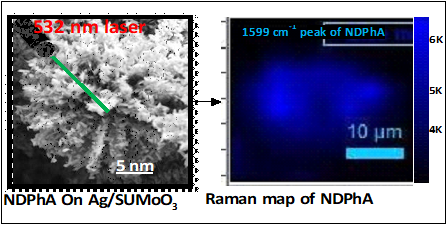Scientists have developed a new low-cost substrate that can increase the sensitivity of Surface-enhanced Raman spectroscopy (SERS) -- a vital analytical and sensing tool for detecting molecules. It can aid rapid detection of toxic pollutants present in water, food, etc.
Surface-enhanced Raman spectroscopy (SERS) has emerged as a vital analytical and sensing tool for detecting molecules. When molecules near the noble metal nanoparticles of gold, silver, platinum, etc., their Raman signals will substantially increase, which can help detect trace amounts of analyte molecules. However, as noble metals are expensive, have poor uniformity, and cannot be reused, there is a quest for alternative SERS active substrates involving non-noble metals. In this regard, semiconductor oxides have emerged as promising materials for the fabrication of SERS substrates.
Scientists from the Centre for Nano and Soft Matter Sciences (CeNS), an autonomous institute of the Department of Science & Technology (DST), Govt. of India, have designed an efficient SERS substrate based on unique sea urchin morphology of molybdenum trioxide for the rapid detection of industrial pollutants. In a series of research works published in the journals Nanoscale Advances, Materials Today Communications, and Nanotechnology, Dr. Ramya Prabhu B, Dr. K. Bramhaiah, Kaushalendra Singh, Meenakshi Varier, and Dr. Neena S John have shown the utility of MoO3 sea urchins for the detection of dye pollutants. Sea urchin structures possess multitude of one-dimensional (1D) spikes that can provide high surface area for analyte adsorption and hotspots for enhancing Raman signals. They prepared the sensitive SERS substrate using a simple technique involving chemical bath deposition where in MoO3, sea urchins are directly grown on glass substrates from a solution of ammonium heptamolybdate and nitric acid at 90 °C.

Subsequently, they demonstrated that when a small amount of silver is added, the sensitivity can be enhanced further. This can help detect nitrosamine toxic pollutants such as N-nitroso diphenylamine (NDPhA). Silver nanoparticles are deposited on sea urchins by thermal evaporation or by photoreduction of silver nitrate. Their findings were supported by simulated vibrational spectra (part of a molecular spectrum in which the bands arise from quantized changes in the energy of mutual atomic vibrations within the molecule) of NDPhA in collaboration with Dr. C. Kavitha from BMS Institute of Technology & Management Bengaluru. “NDPhA is a potent carcinogen and a severe threat to mankind. Detection of NDPhA requires expensive and sophisticated analytical instruments. However, using the developed SERS substrates, rapid detection of NDPhA is possible,” explained Dr. Ramya Prabhu B, the lead researcher.
The researchers found that MoO3 sea urchins are rich in surface defects and oxygen vacancies, and their tapered tips have abundant surface hydroxyl groups that favor the binding of more analyte molecules. The deposition of Ag nanoparticles on the spikes of sea urchin structures further enhances its SERS properties resulting in a substrate with enhanced sensitivity. The substrate is promising for the trace detection of other toxic dyes and chemicals.
Publication links:
https://doi.org/10.1039/C9NA00115H
https://doi.org/10.1016/j.mtcomm.2022.104995
https://doi.org/10.1088/1361-6528/acbcdb
For more details, contact Dr. Neena S John jsneena[at]cens[dot]res[dot]in






























